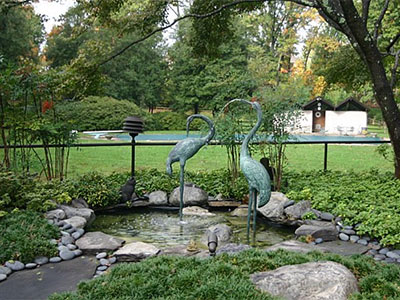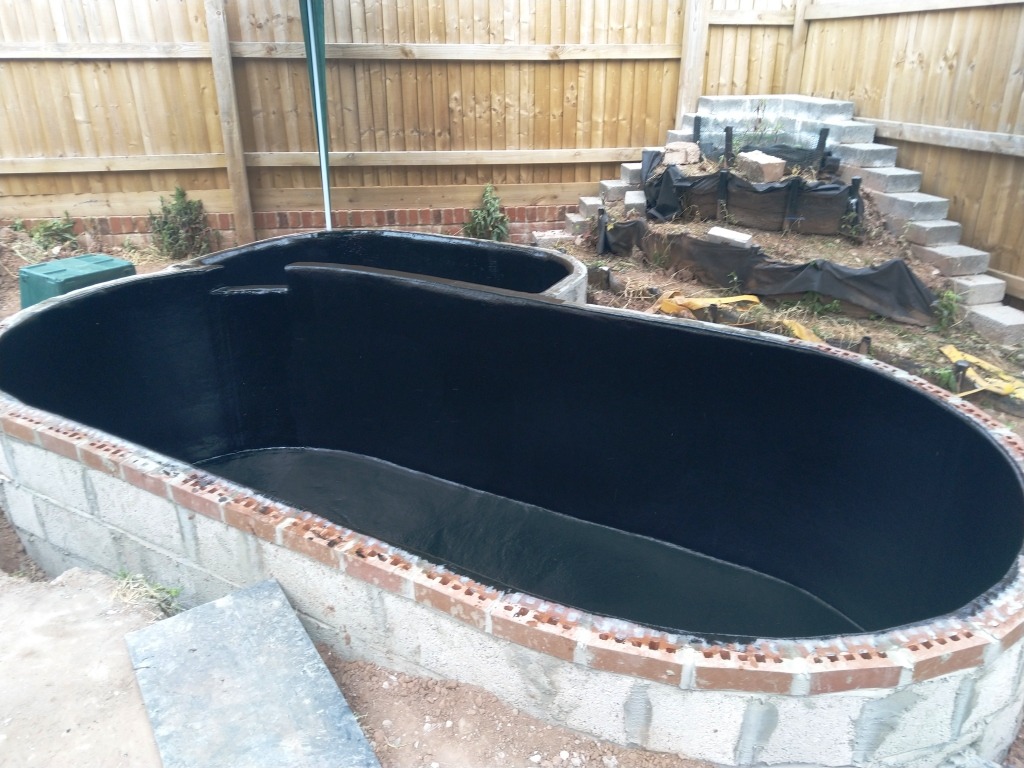Fiberglass Pond Liners
Fiberglass pond liners, part of the 'preformed' family of pond liners, are purchased in a predetermined shape and size. As a pond liner, fiberglass is an excellent material. It is tough, long-lasting, and relatively easy to install.
Fiberglass is not prone to cracking like plastic and does not require confinement around the liner, as preformed plastic liners do. By not requiring confinement, we mean that the liner does not have to be completely surrounded by compacted sand or soil to help support it. In the case of preformed plastic liners, confinement is important to prevent the plastic liner from bending out of shape and cracking. In the case of fiberglass ponds, it is not even necessary to dig a hole for the pond. If desired, a fiberglass pond liner can be placed directly on the ground, and then concealed with rocks, plants, and other landscaping materials to create a pond that is elevated above the ground level. One downside of fiberglass liners is that they are often large and heavy to ship. It was for this reason that we created our 3D shaped box-welded liners. These liners, made from a flexible material, can be folded up in a box for shipping, which helps keep the cost down. They just need to be installed in some kind of wood or block frame.

A fiberglass pond by Wewerka Construction Management
Preformed Pond Liners

Other Advantages
One of the main advantages of fiberglass pond liners is the ease of installation. Unlike other liner systems, fiberglass is a littler harder to get wrong. Other than breaking the liner itself, the chance of creating a leaking pond is small. Fiberglass ponds are also quite resilient to winter conditions, as the material is able to flex slightly in the presence of ice.
Precast liners are available in a variety of interesting shapes and sizes, and because of their preformed shape, do not contain any folds or unsightly creases like a standard rubber or PVC pond liner would.
Possible Downsides to Fiberglass Pond Liners
The main problem with fiberglass pond liners is their expense. Fiberglass ponds typically cost much more in materials than a similarly sized pond using a flexible pond liner. Additionally, due to their rigid and heavy nature, the shipping costs for fiberglass ponds can be many times more expensive than shipping a flexible liner.
Another potential issue is the shallow water depth in most fiberglass ponds. Often, preformed ponds are simply too shallow to properly control water temperature. This is a significant consideration for a fiberglass koi pond, as koi and other types of fish require a relatively consistent water temperature. However, this can be overcome by purchasing a pond that holds more than 1000 gallons, or 4500 liters of water. The larger the volume of water in a pond, the slower it will react to temperature changes. Additionally, try to get a preformed pond with as much depth as possible, since deeper water also helps regulate temperature. We recommend at least 3 feet of water depth for fish. If you have no plans for putting fish in your pond, then water temperature fluctuations may be less important, depending on your goals.
As mentioned above, our 3D Shaped Rectangular or Circular Drop-in Liners are a great alternative to fiberglass liners. They can be rolled up in a box for shipping, are strong and light. The downside is they are generally only made in rectangular, circular shapes or L shapes.
Alternatives to Fiberglass Pond Liners
Box-welded liners are a good alternative to fiberglass in certain situations. Box-welding is the process of taking a flat liner and heat welding the seams to create some kind of 3D shape or 'box'. We carry a 45 mil polypropylene liner that box-welds quite nicely into various rectangular or circular shapes. We are able to box-weld the liner at our facility so that it arrives in the desired shape, ready to go. Like fiberglass, our polypropylene is safe for fish, plants, and humans. In fact, it is approved for human drinking water applications, so any form of fish farming, aquaponics, or gardening for human consumption is also approved. The main benefit of the pre-box-welded liners is their cost - they are much less expensive than fiberglass, and much less expensive to ship. The one possible disadvantage of box-welded liners over fiberglass is that they are flexible, which means they must be supported. For example, if building an above-ground pond, tank, or filter, some kind of frame must be built to support the liner. This can easily be built out of wood and then camouflaged with landscaping, rocks, or other material. If placing the liner below ground, as long as the liner is properly backfilled with soil or other fill, the liner will have plenty of support in-ground. To learn more, or see prices, please visit the box-welded liner section in our store.
Fiberglass ponds are sometimes also called glassfibre ponds.
Click Here to Return from Fiberglass Pond Liners to Pond Liners
Click Here to Return from Fiberglass Pond Liners to our Home Page
